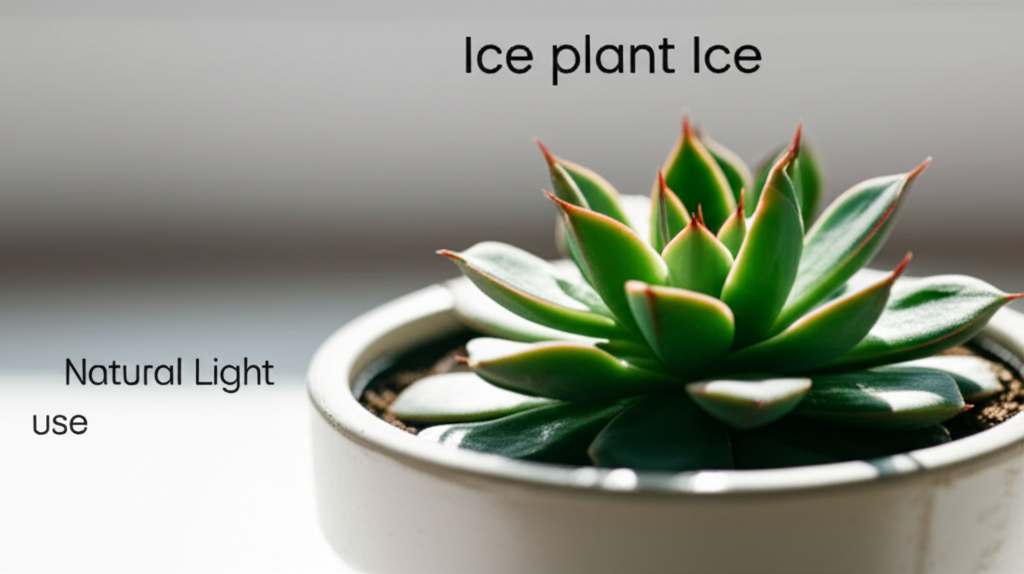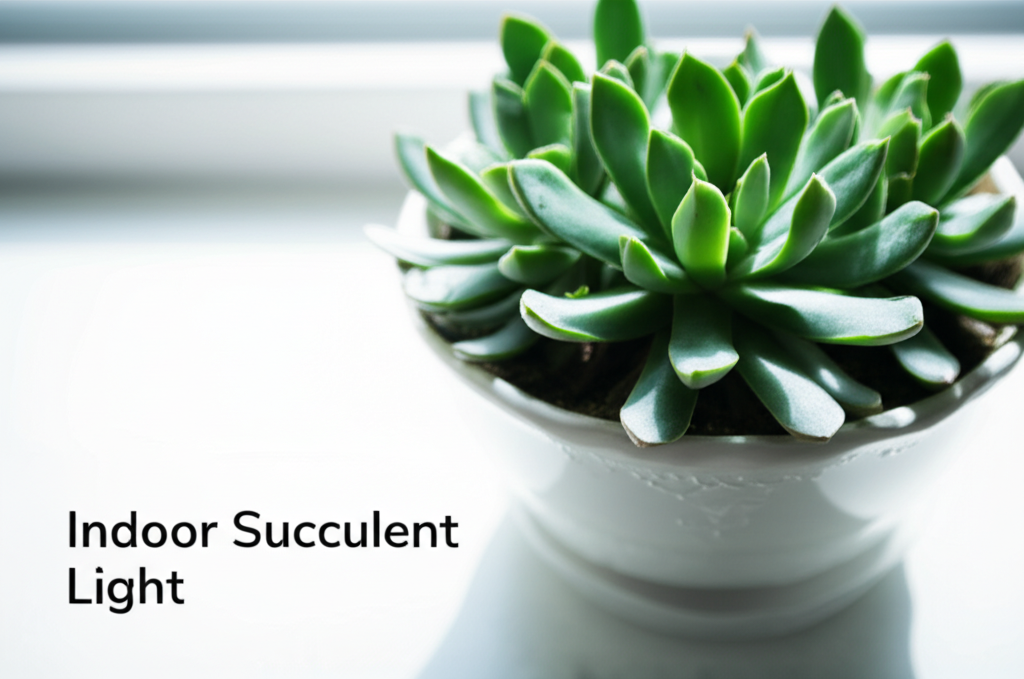The Allure of the Ice Plant Succulent Indoors
Ice plant succulents, scientifically known as members of the Aizoaceae family, are captivating additions to any indoor plant collection. Their common name derives from the glistening, transparent vesicles (papillae) that cover their leaves, mimicking tiny droplets of ice. These remarkable adaptations serve a crucial purpose: to reflect excess sunlight and trap moisture in arid environments. Bringing these desert natives indoors offers a unique aesthetic and a rewarding gardening experience, but understanding their intricate relationship with natural light is paramount to their thriving.
Successfully cultivating ice plant succulents indoors hinges on providing them with the right amount of natural light. Too little, and they become leggy, pale, and prone to rot. Too much direct, scorching sun, especially through glass, can lead to sunburn and irreversible damage. This article will delve deep into how to optimize natural light utilization for your ice plant succulents, ensuring they flourish and showcase their mesmerizing crystalline beauty.
Understanding Ice Plant Succulent Light Needs

At their core, ice plant succulents are adapted to harsh, sun-drenched environments. In their native habitats, they often grow in sandy, well-draining soils with minimal shade. This evolutionary history dictates their indoor light requirements. They are heliotropic, meaning they will orient themselves towards the brightest available light source.
The Spectrum of Light Intensity
Natural light for houseplants can be broadly categorized into several intensities:
- Bright, Direct Light: This is typically found in south-facing windows (in the Northern Hemisphere) or west-facing windows that receive several hours of direct, unfiltered sunlight daily.
- Bright, Indirect Light: This occurs when light is filtered through sheer curtains, is several feet away from a bright window, or is in an east-facing window that receives morning sun.
- Medium Light: Found in rooms with windows that don’t receive direct sun, or further into a room with bright windows.
- Low Light: Areas far from any windows or in north-facing windows.
Ice plant succulents generally fall into the category requiring bright, indirect light for optimal growth and coloration. While they can tolerate some direct sunlight, particularly morning sun, intense afternoon sun can be detrimental.
Signs of Inadequate Light
Your ice plant succulent will communicate its light needs through subtle (and sometimes not-so-subtle) visual cues. Recognizing these is key to troubleshooting and adjustment:
- Etiolation (Limpiness and Stretching): If your succulent begins to stretch out, with increased spacing between leaves and a general “leggy” appearance, it’s searching for more light. The vibrant colors may also fade, and the plant might become pale green.
- Lack of Color: Many ice plant varieties display stunning hues of pink, purple, red, or vibrant green. Insufficient light will result in a duller, more uniform green.
- Weak Growth: New leaves may be smaller and less plump than older ones, indicating the plant isn’t receiving enough energy to grow robustly.
- Increased Susceptibility to Rot: While overwatering is the primary culprit, plants deprived of light also struggle to dry out properly, making them more vulnerable to fungal diseases and root rot.
Signs of Excessive Light
Conversely, too much intense light can also cause distress:
- Sunburn: This appears as bleached, brown, or crispy patches on the leaves. These areas are typically dry and inelastic. Sunburn is permanent, so affected leaves usually need to be removed.
- Leaf Shrinkage/Wrinkling: In extreme cases, the translucent papillae can dry out and shrivel, causing the entire leaf to appear puckered or shrunken.
- Washing Out of Colors: While some succulents develop deeper colors in brighter light, excessive intensity can sometimes “wash out” vibrant pigments, leading to a pale or whitish appearance.
Optimizing Natural Light Placement
The most critical factor in successful indoor cultivation is selecting the right location. Think of your home as a landscape and place your ice plant succulent accordingly.
Window Direction as a Guide
The direction your windows face significantly impacts the intensity and duration of sunlight:
- South-Facing Windows (Northern Hemisphere): These offer the most intense and longest duration of sunlight. Ideal for most succulents, but ice plants might need to be placed a few feet back from the glass or have their light filtered during the hottest parts of the day.
- East-Facing Windows: Provide gentle morning sun, which is usually well-tolerated by ice plants. They can often be placed directly in or very close to an east-facing window without issue.
- West-Facing Windows: Offer afternoon sun, which can be very intense and hot. Ice plants in west-facing windows generally require placement further from the glass or protection from direct rays from midday onwards.
- North-Facing Windows: Provide the least amount of direct light and are generally not bright enough for most ice plant succulents to thrive.
Utilizing Window Treatments
Window treatments can be your best friend in regulating light intensity:
- Sheer Curtains: These are excellent for diffusing harsh direct sunlight, creating a soft, bright, indirect light environment that is perfect for ice plants.
- Blinds/Shutters: Adjustable blinds or shutters allow you to control the angle and intensity of the light throughout the day. You can tilt them to bounce light off the ceiling or walls, or partially close them during peak sun hours.
- Window Films: Frosted or UV-filtering window films can also be applied to windows to reduce the intensity of direct sunlight without significantly blocking light overall.
Seasonal Adjustments
The sun’s angle and intensity change throughout the year. Be prepared to make adjustments:
- Winter: Days are shorter, and the sun’s angle is lower. You might be able to move your ice plant closer to windows or even a bit more direct sunlight.
- Summer: The sun is higher and hotter. During the hottest months, you’ll likely need to ensure your ice plant is shielded from prolonged, intense direct sun, especially in south and west-facing windows.
A Comparative Look at Light Utilization
Here’s a table to help compare common placement options for ice plant succulents:
| Window Direction | Typical Light Intensity | Suitability for Ice Plants | Considerations |
|---|---|---|---|
| South | Bright, Direct (most intense) | High, with caution | May require filtering/distance during peak summer sun. |
| East | Bright, Indirect (morning sun) | Excellent | Generally safe for direct placement. |
| West | Bright, Direct (afternoon sun) | Moderate, with caution | Needs protection from intense afternoon heat. |
| North | Low to Medium | Low | Unlikely to provide sufficient light for optimal growth. |
Beyond Natural Light: Supplemental Lighting Considerations
While the goal is to maximize natural light, sometimes it’s simply not enough, especially during shorter winter days or in homes with limited natural light.
When to Consider Supplemental Light
If you observe the signs of inadequate light mentioned earlier, even with the best natural light placement, it’s time to consider artificial help.
Types of Grow Lights
Modern grow lights are efficient and can mimic the full spectrum of sunlight plants need:
- LED Grow Lights: Energy-efficient, long-lasting, and available in full-spectrum options. They produce less heat, making them safer for indoor environments.
- Fluorescent Grow Lights: A more budget-friendly option, with T5 fluorescent bulbs being particularly effective.
Best Practices for Supplemental Lighting
- Full Spectrum: Ensure your grow light emits a full spectrum of light (including blue and red wavelengths) crucial for photosynthesis.
- Distance: Position the light at an appropriate distance from your plant. Follow the manufacturer’s recommendations, but typically 6-12 inches is a good starting point.
- Duration: Aim for 12-16 hours of light per day, mimicking a natural day cycle.
- Avoid Overlap: If using multiple lights, ensure they don’t create overly bright spots that could burn the plants.
The Interplay: Light, Water, and Soil
It’s crucial to remember that light is just one part of the puzzle. Optimal light utilization works in conjunction with proper watering and well-draining soil.
Watering Practices
Ice plant succulents are drought-tolerant. Overwatering is the most common cause of death.
- “Soak and Dry” Method: Water thoroughly when the soil is completely dry to the touch. Allow excess water to drain away completely.
- Frequency: This might be every 2-4 weeks during the growing season (spring/summer) and much less frequently (monthly or even less) during their dormant period (fall/winter).
- Observe the Plant: Signs of thirst include slightly deflated or wrinkled leaves.
Soil Composition
A well-draining potting mix is non-negotiable.
- Cactus/Succulent Mix: Pre-made mixes are readily available.
- DIY Mix: Combine equal parts potting soil, perlite, and coarse sand or pumice.
The goal is to prevent water from sitting around the roots, which can lead to rot, especially in lower light conditions.
Troubleshooting Common Issues Related to Light
When your ice plant succulent isn’t thriving, assessing its light exposure is often the first step.
Etiolation (Stretching)
- Cause: Insufficient light.
- Solution: Move the plant to a brighter location or supplement with a grow light. You can often prune leggy growth and propagate the cuttings to create fuller plants.
Sunburn (Brown/Crispy Spots)
- Cause: Too much direct, intense sunlight.
- Solution: Move the plant to a location with less direct sun, or use a sheer curtain to filter the light. Sunburned spots will not recover, but new growth should be healthy.
Rot (Mushy base or leaves)
- Cause: Primarily overwatering, but exacerbated by insufficient light which prevents the plant from drying out.
- Solution: Allow the soil to dry out completely between waterings. Ensure excellent drainage. If rot is advanced, you may need to propagate healthy parts of the plant.
A Step-by-Step Guide to Optimizing Light
Here’s a concise plan to ensure your ice plant succulent gets the light it needs:
| Step | Action | Purpose |
|---|---|---|
| 1 | Assess your available window locations and their light exposure throughout the day. | Understand the natural light conditions in your home. |
| 2 | Place your ice plant succulent in a bright location, ideally near an east-facing window or a south/west-facing window with filtered light. | Provide optimal bright, indirect light. |
| 3 | Observe your plant for signs of too much or too little light (stretching, color loss, sunburn). | Monitor the plant’s response to its environment. |
| 4 | Adjust placement or use window treatments (sheer curtains, blinds) as needed to regulate light intensity. | Fine-tune the light exposure to prevent damage. |
| 5 | Consider supplemental grow lights if natural light is insufficient, especially during winter. | Ensure consistent light levels year-round. |
| 6 | Maintain a consistent watering schedule, allowing soil to dry completely between waterings, and use well-draining soil. | Support healthy growth and prevent rot, which is intensified by poor light. |
Conclusion
The mesmerizing beauty of ice plant succulents is best revealed when their specific needs for natural light are met. By understanding the nuances of light intensity, strategically placing your plants near appropriate windows, and being prepared to adjust with seasonal changes or supplemental lighting, you can unlock their full potential. Observing your plants closely for any signs of stress and responding accordingly will ensure these unique desert gems bring a touch of crystalline wonder to your indoor oasis. Mastering their light utilization is the key to their vibrant health and captivating display.


